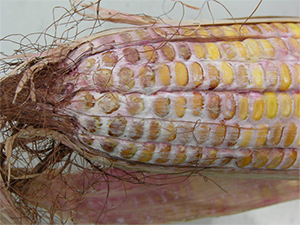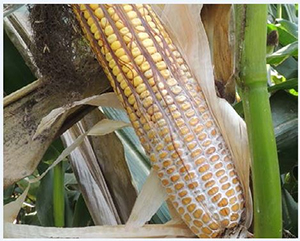When ear rot is present, the following storage and feeding precautions are advisable:
- Harvest as early as possible
- If insect or bird damage is evident, harvest outside damaged rows separately. Keep and handle the grain from these rows separately.
- Adjust harvest equipment to minimize damage to corn. Clean corn thoroughly to remove pieces of cob, small kernels and red dog.
- Cool the grain after drying
- Clean bins before storing new grain
- Check stored grain often for temperature, wet spots, insects and mould growth
- Control storage insects
- Exercise caution in feeding mouldy corn to livestock, especially to hogs. Pink or reddish moulds are particularly harmful. Suspect samples should be tested for toxins.
How can you tell the difference between the 3 primary ear moulds found in Ontario?
Gibberella Ear Rot: The most common and important ear mould in Ontario is caused by Gibberella zeae which is the sexual reproductive stage of Fusarium graminearium. This fungus also causes FHB in small grains like wheat and can survive on soybean roots. Although the fungus can produce a white-coloured mould which makes it difficult to tell apart from Fusarium Kernel Rot, the two can be distinguished easily when Gibberella produces its characteristic red or pink colour mould (Figure 1). Infection begins through the silk channel and thus, in most cases starts at the ear tip and works its way down the ear. In severe cases, most of the ear may be covered with mould growth. Corn silks are most susceptible 2–10 days after emerging. Warm and wet weather during this period is ideal for infection.
Figure 1. Gibberella ear rot - Red/pink mould which often begins on ear tip (OMAFRA)

Fusarium Kernel Rot: Unlike Gibberella, Fusarium infected kernels are often scattered around the cob amongst healthy looking kernels or on kernels that have been damaged for example by insects or birds. Fusarium infection produces a white to pink or salmon-coloured mould. A “white streaking” or “star-bursting” can be seen on the infected kernel surface (Figure 2). Although many Fusarium species may be responsible for these symptoms, the primary species we are concerned about in Ontario is Fusarium verticillioides. Fusarium survives in corn debris. The significance of this fungus is that it produces a toxin called fumonisin that has been shown to cause cancer (carcinogen) in humans. The environmental conditions that favour disease development are warm, wet weather 2–3 weeks after silking.

Figure 2. Fusarium ear rot – White/pink mould anywhere on ear (OMAFRA)
Diplodia Ear Rot: The characteristic ear symptom of Stenocarpella maydis and S. macrospora infection is a white mould that begins at the base of the ear which could cover and rot the entire ear (Figure 3). Mould growth can also occur on the outer husk which has small black bumps (pycnidia) embedded in the mould. These reproductive structures are where new spores are produced. Pycnidia (the small, black, spore-producing structures of the fungus) overwinter on corn residue and are the source of infection for the subsequent corn crop. Dry weather before silking, immediately followed by wet conditions, favor Diplodia infection.
Figure 3. Diplodia ear rot – Mould begins at base (Crop Protection Network)Figure 3. Diplodia ear rot – Mould begins at base (Crop Protection Network)

Source : fieldcropnews